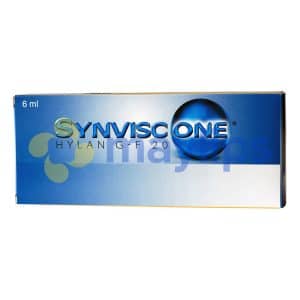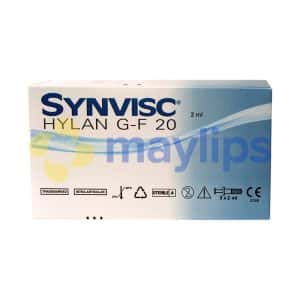Showing all 2 results
Buy SYNVISC® Online - Products From Leading Wholesaler At Low Prices
Buy SYNVISC® Online - Products From Leading Wholesaler At Low Prices
-


SYNVISC ONE®
8mg/ml 1-6ml prefilled syringe
159.00 $ Add To Cart-+

SYNVISC® 3x2ml
3x2ml 8mg/ml 3-2ml prefilled syringes
159.00 $ Add To Cart-+*Disclaimer: Information on Maylips.com is provided for informational purposes only. Self-medication is strictly prohibited. All aesthetic procedures should be provided by the licensed healthcare specialist or doctor after the consultation with the personal therapist, as per standard policy for treatment. The information in this article should not be used for prescribing any medication for the beauty injections.
All brand and medication descriptions in the article are based on the personal opinion and are not endorsed by Maylips.com. The article content was not reviewed for medical validity. Use this article for information and not for a final decision on the procedure.
WHAT IS SYNVISC?
It is an animal-based orthopaedic implant designed to alleviate pain and discomfort in synovial joint sites affected by arthritis. Its active ingredient is 8mg/mL of chemically cross-linked hylan derived from rooster combs—the fleshy crest on top of rooster heads. Other ingredients include 8.5mg/mL of sodium chloride, 0.16mg/mL of disodium hydrogen phosphate, 0.04mg/mL of sodium dihydrogen phosphate hydrate, and water for injection. The resulting gel is very viscoelastic, bioresorbable, and tissue-friendly. There are 2 different versions available in the Synvisc products range, and each have a different volume of product supplied in a single syringe. Nevertheless, the implant formulation is exactly the same. View product specific details below:
- Synvisc: The orthopaedic implant comes in a prefilled 2mL syringe and each box contains 3 preloaded syringes, labels to ensure traceability, and a device manual with policy. Clients should receive 3 injections for the best relief outcome.
- Synvisc One: This single-dose orthopaedic implant comes in a prefilled 6mL syringe and each box contains only 1 syringe, labels to ensure traceability, and a device manual. Just a single dose is adequate to deliver ideal pain-relieving actions.
For both of the above Synvisc products, needles are to be obtained separately according to the sites being treated. The fragile packaging is sterile and must be kept in a clean room with temperature ranging between 2ºC to 30ºC, shielded from light, a regular policy to follow. Synvisc product is manufactured by Genzyme.
WHAT IS IT USED FOR?
Synvisc is used to correct the effects of painful arthritis and other debilitating symptoms in various synovial joints, especially for patients who have not found successful treatment with non-pharmacological therapies (e.g. mobility support gears, analgesics, oral supplements, etc.). Some of the specific sites that are frequently treated with injections of Synvisc-One and others include:
- Hip: The hip is a type of ball and socket synovial joint formed between the hip bone and the thigh bone. Being one of the largest weight-bearing joints, it provides stability to body.
- Knee: The knee is a modified synovial hinge joint formed between 3 bones: the femur (thigh bone), the tibia (shin bone), and the patella (knee cap). Besides helping us to move, the knee also supports the body’s weight.
- Shoulder: The shoulder is made of 3 bones: the scapula (shoulder blade), the clavicle (collarbone), and the humerus (upper arm bone).
- Ankle: The ankle is made of 3 bones: talus (in the foot), the tibia, and the fibula (in the leg). This synovial hinge joint is responsible for movement between the leg and foot.
HOW DOES IT WORK?
Synvisc acts as a viscosupplement and shares almost identical viscoelastic properties to naturally-occurring synovial fluid. Once injected, it replenishes the lost fluid and lubricates the bones so they glide over each other smoothly. The synovial joint is marked by its flexibility and synovial fluid. The ends of the bones encompassed within the synovial membrane are protected with a layer of articular cartilage. This cartilage continuously secretes synovial fluid into the space, in a process called weeping lubrication. At its prime, synovial joints provide smooth movement while absorbing sudden shocks. However, degenerative disorders emerge when this string cartilage breaks down, resulting in a sharp decline of lubricating fluid. This causes the bones to grind excruciatingly against each other, inducing inflammatory responses in neighbouring tissues. If left untreated, clients may lose complete mobility due to agonising pain and stiffness. Consequently, with Synvisc treatment, pain and discomfort is alleviated, and patients can resume their daily activities with greater ease. A large amount of information is available about Synvisc and Synvisc-One injections online.
HOW TO INJECT SYNVISC?
Injecting Synvisc is considered a medical procedure and can only be conducted by licensed physicians with vast experience in injecting orthopaedic implants adhering to proper policy and practices. It is also important to adhere to stringent aseptic techniques to ensure a minimal risk of infection and cross-contamination. Before administering the Synvisc implant, it is very important to thoroughly sanitise the treatment site as per standard policy and remove any fluid build-up from the affected areas. Needles sizes of 18G to 22G are recommended depending on the joints being treated. Inject the Synvisc implant intra-articularly into the synovial space of the problematic knee joint. After the session is completed, discard any free remaining Synvisc gel and used needles in accordance with proper safety procedure. As part of aftercare, advise your clients to apply a cold compress to the treated site united with avoiding high impact activities like tennis and jogging. You can also prescribe to your clients, oral analgesics to provide greater relief while any side effects from the treatment clear up.
HOW OFTEN TO USE?
The Synvisc injection sessions are scheduled differently depending on which variation of the Synvisc product is used:
- Synvisc: Administer 1 treatment weekly for a total of 3 injections on the affected knee joints. The maximum dosage is 6 injections within 6 months, with a minimum 1 month break between sessions. Others like the hips, shoulders, and ankles may only need 1 treatment for improvement and relief. However, a second treatment can still be given 1 to 3 months time after the initial knee treatment session if clients do not regain comfort and mobility. Visit Maylips.com for more details on buying Synvisc-One online.
- Synvisc One: A single-dose implant variant of Synvisc Synvisc-one means the entire 6mL syringe is adequate to treat a knee in a single session. Check online for more reasons to buy Synvisc-One injections products.
HOW LONG DOES IT LAST?
Patients can notice improvements within a month after completing Synvisc treatment, and these desirable effects can last for approximately six months. Since the classic Synvisc implant is completely biodegradable, it will disintegrate into the nearby tissues, at which point clients can obtain more viscosupplement injections as necessary. The duration of the effect of the Synvisc implant varies greatly depending on age, health status, and lifestyle choices.
How Much Does It Cost To Buy Synvisc?
The exact cost to buy Synvisc products varies depending on the variation of Synvisc to order as well as the dosage the customer needs (occasionally requiring the purchase of wholesale orthopedics). The majority of online sources, such as wholesaler, suppliers or distributors can offer a bulk discount on their online store. All variants of Synvisc are available as a wholesale product at the wholesale price
Where Can I Buy Synvisc?
To obtain exact prices, make sure to browse the Synvisc product range at MayLips.com supplier shop and contact us for more information on how to order online. In-stock notification is updated regularly, for those with a customer account interested to order Synvisc on our online shop, where the price is displayed.
The most convenient method to realize this wholesale price is to use your customer account online to get more information and to order Synvisc products such as Synvisc-one online at a fair price. With this information you can be more informed on the process to buy wholesale orthopedics from online wholesale or bulk suppliers.
IS THIS PRODUCT SAFE?
Yes, Synvisc implants are very safe and effective, as the active ingredients are sourced from high-quality materials. Its active ingredient—hylan—is derived ethically from rooster combs, and 2 decades of research has been proven it Hylan to be tolerated well by the human body. The resulting gel is also purified to ensure a very low risk of inducing immunogenic reactions. That being said, some people are still contraindicated from this viscosupplement, including:
- Patient who is allergic to avian products (e.g. eggs, feathers, poultry);
- Patient who is younger than 18 years old;
- Patient who is pregnant or breastfeeding.
Do not inject this Synvisc implant in a site with active skin inflammation or infections.
SYNVISC INJECTION SIDE EFFECTS
Clients might experience some common after effects caused by the injection process.
COMMON SIDE EFFECTS:
- Pain on treated joint;
- Irritation on treated joint;
- Fluid build up on treated joint;
- Swelling on treated joint;
- Sensation of heat on treated joint.
These reported adverse effects are usually very moderate in nature and will subside within a couple of days. A patient can reduce downtime by following the recommended aftercare methods, such as applying ice packs and avoiding very strenuous exercise sessions for at least 48 hours following Synvisc treatment. On rare occasions, serious adverse events have been reported by some patients.
SERIOUS SIDE EFFECTS:
- Difficulty swallowing/breathing/talking;
- Hives;
- Nausea/vomiting;
- Headache/dizziness;
- Muscle ache;
- Fever/chills;
- Increased heart rate.
These symptoms indicate an allergic attack, which can be fatal if left untreated. The patient must get immediate treatment at the nearest hospital if these symptoms appear.
WHAT IS IT MADE OF?
Synvisc is an animal-based viscosupplement designed to alleviate pain in knee joints damaged by degenerative diseases like osteoarthritis. This orthopaedic implant gel is viscoelastic, bioresorbable, and tissue-friendly. The active ingredients are 8mg/mL of chemically cross-linked hylan, accompanied by other gel constituents like 8.5mg/mL of sodium chloride, 0.16mg/mL of disodium hydrogen phosphate, 0.04mg/mL of sodium dihydrogen phosphate hydrate, and water for injection. Hylan is ethically harvested from rooster combs. After completing Synvisc treatment, the lubricating synovial fluid is replenished, resulting in minimal pain and discomfort in the affected site during movement.

